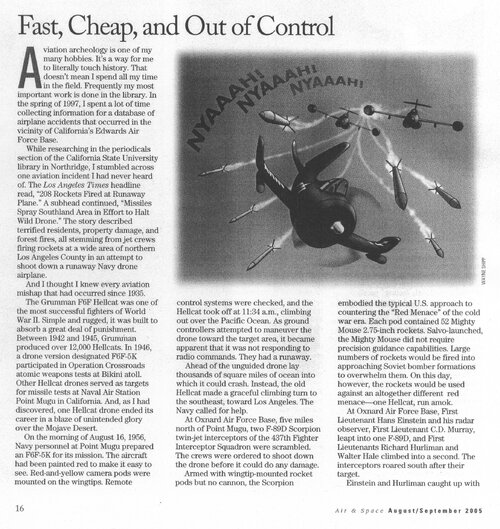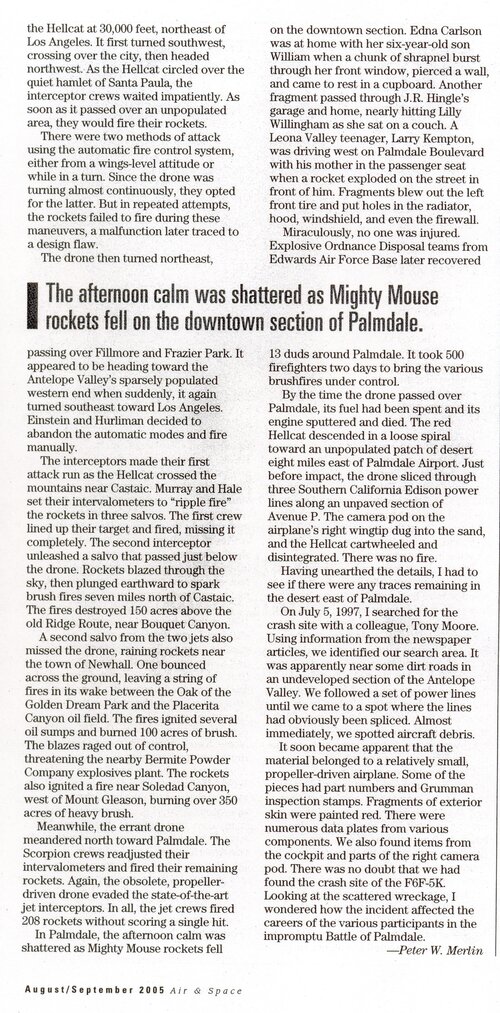You are using an out of date browser. It may not display this or other websites correctly.
You should upgrade or use an alternative browser.
You should upgrade or use an alternative browser.
The Battle of Palmdale – WW2 Drone Hellcat vs F-89 Scorpion Jet Interceptors
- Thread starter Justo Miranda
- Start date
BlackBat242
OK, I changed my personal text ;)
- Joined
- 10 April 2013
- Messages
- 1,211
- Reaction score
- 3,316
Colonial-Marine
UAVs are now friend, drones are the real enemy.
- Joined
- 5 October 2009
- Messages
- 1,378
- Reaction score
- 1,136
Would have it been possible to fit these rockets with proximity fuzes? How was the fire control system supposed to work for the crew, did a gunsight automatically account for the range determined by the radar?
It definitely doesn't give much confidence in the rocket armament of some of these early interceptors. Sure a Soviet bomber is a bigger target, but it would also be shooting back if the interceptors got too close which tends to have a disruptive affect on aiming.
It definitely doesn't give much confidence in the rocket armament of some of these early interceptors. Sure a Soviet bomber is a bigger target, but it would also be shooting back if the interceptors got too close which tends to have a disruptive affect on aiming.
Yes, the Army later developed the M429 VT fuze. However, this was late-Vietnam era and would detonate itself due to interference if you fire more than one at a time.Would have it been possible to fit these rockets with proximity fuzes? How was the fire control system supposed to work for the crew, did a gunsight automatically account for the range determined by the radar?
It definitely doesn't give much confidence in the rocket armament of some of these early interceptors. Sure a Soviet bomber is a bigger target, but it would also be shooting back if the interceptors got too close which tends to have a disruptive affect on aiming.
There just wasn't a compelling reason to give F-89s a VT fuze when the weapons system was only a stopgap until actual missiles showed up.
War Thunder gave the (premium!) F-89D VT fuzes but that is its won separate thing that I argued about elsewhere
That story is so baffling... I wonder whether they should have tried the old trick used by Spitfires against V-1s: wingtip to wingtip.
... then again, it also happened to F-102s. When they went chasing cruise missiles (Matador or Snark, can't remember) gone rogue, and never caught up. One of the cruise missiles was later found... in south america jungle.
... then again, it also happened to F-102s. When they went chasing cruise missiles (Matador or Snark, can't remember) gone rogue, and never caught up. One of the cruise missiles was later found... in south america jungle.
Manuducati
ACCESS: Secret
- Joined
- 25 November 2020
- Messages
- 289
- Reaction score
- 876
That story is so baffling... I wonder whether they should have tried the old trick used by Spitfires against V-1s: wingtip to wingtip.
... then again, it also happened to F-102s. When they went chasing cruise missiles (Matador or Snark, can't remember) gone rogue, and never caught up. One of the cruise missiles was later found... in south america jungle.
Interesting story for sure (but maybe not the same one as they do not mention the F-102 interception)!
The Day They Lost the Snark | Air & Space Forces Magazine
Nearly 50 years ago, a big red aircraft made an unexpected landing in the Amazon.
Similar threads
-
MAR 30, 1954 NORTHROP AIRCRAFT F-89 INTERCEPTOR STATUS REPORT #501 OF 700 COPIES
- Started by edwest4
- Replies: 0
-
F-105 and the Semi-Automatic Ground Environment (SAGE)
- Started by yahya
- Replies: 1
-
-
-
I-70: Interceptor Version of the XB-70 Valkyrie?
- Started by Christopher Wang
- Replies: 22




